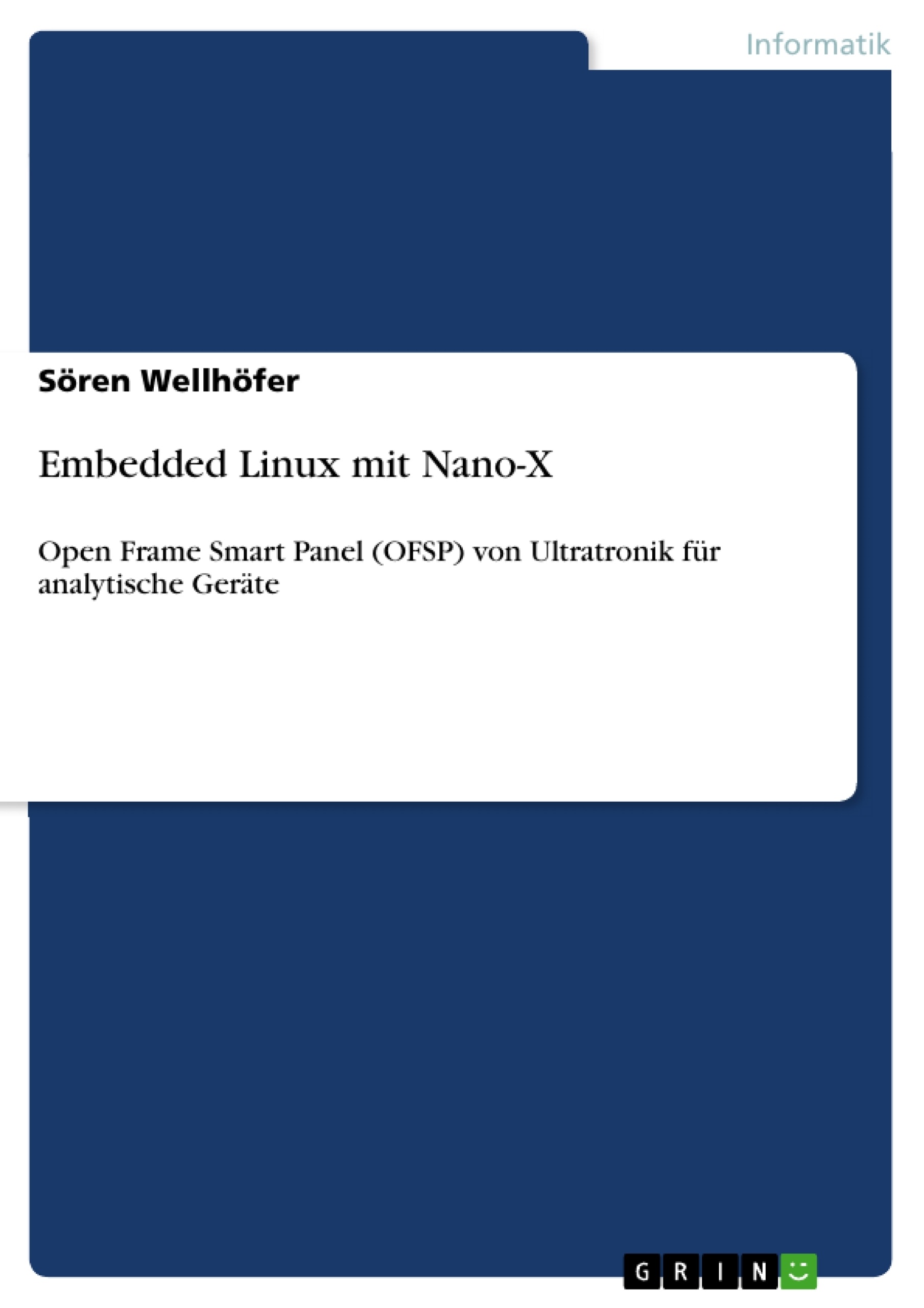Software developers for embedded devices have just now begun to discover the power of developing and running their software on GNU/Linux.
As graphical environments on embedded devices have also become a crucial point for any kind of application it is majorly important to use a stable and flexible graphics system for this purpose.
Therefore, this paper makes the far-reaching attempt at explaining, describing and elaborating on Nano-X, THE free and OpenSource graphical windowing environment of choice for smaller devices.
Unfortunately, up to this point, material concerning good and complete introductions to the Nano-X API is rarely to be found. With this paper a resourceful piece of collected and easy-to-understand compact knowledge base has been compiled for practical or any other kind of use.
As this paper has been intentionally written to be used within the frames of software development for analytical gadgets, a concrete device, that is the Open Frame Smart Panel (OFSP) from Ultratronik, is taken under scrutiny and shown to be a viable device for the tasks at hand.
Furthermore, some additionally relevant topics concerning Unix (especially serial port communication) are also discussed in some detail.
Inhaltsverzeichnis
- Einleitung
- Grundlegendes
- Software und Analysetechnik
- Problemstellung
- Hardware
- OFSP Open Frame Smart Panel
- Betriebssoftware
- Embedded-Systems
- Windows CE™
- Ultratronik Linux Distribution
- X-Window Systeme
- Cross-Compiler
- Nano-X - Die schlanke X-Window Variante
- Gesamtüberblick
- Lizenz und Bedingungen
- Einrichtung des Systems
- Einführung in die Nano-X Programmierbibliothek
- Fenster
- Graphische Kontexte
- Ereignisse
- Ereignistypen
- Ereignisverarbeitung
- Ereignisorientierte Anwendungsprogrammierung
- Der Nano-X Server
- Nano-X API und Microwindows API
- Kernkonzepte im Vergleich
- Nano-X API oder Microwindows API - Ein Fazit
- State Saver - Visueller Zustandsspeicher
- Verwendung
- Funktionsweise
- Kompilierungshinweise
- dkbd-Eine virtuelle Tastatur für das OFSP
- Anwendungskonzeption
- Programmiertechnische Umsetzung
- Abstrakt
- Grundlegender Code
- Ereignisverarbeitender Code
- Die Tiny Widgets Bibliothek
- Grundlegendes
- Grundlegende Verwendung
- Zusammenfassung
- Ausblick
- Anhang I
- Linux Serialschnittstellenkommunikation
- Grundlegendes
- Überprüfung der Schnittstellenfunktionalität
- Programmierung
- Linux Serialschnittstellenkommunikation
- Anhang II
- Nano-X Kurzreferenz
- Fenstereigenschaften
- Ereignisstrukturen und Ereignistypen
- Nano-X Zeichenroutinen
- Nano-X Kurzreferenz
- Anhang III
- Quelltext der virtuellen Tastatur „dkbd“
- Der Zustandsspeicher „state saver“
- Quelltext eines einfachen Nano-X Ladebalkens
- Quelltext der Tiny-Widgets und Serialport-Testanwendung
- Glossar
Zielsetzung und Themenschwerpunkte
Diese Seminararbeit zielt darauf ab, eine solide Wissensbasis und einen Ausgangspunkt für die Entwicklung von Embedded Linux-Anwendungen für das Open Frame Smart Panel (OFSP) von Ultratronik zu schaffen. Die Arbeit konzentriert sich auf die Grundlagen der Entwicklung graphischer Anwendungen mit der Nano-X Bibliothek, da für diese nur wenige und unzureichende Anleitungen existieren.
- Grundlagen von Embedded Linux und Nano-X
- Entwicklung graphischer Benutzeroberflächen mit Nano-X
- Anwendung der Tiny-Widgets Bibliothek
- Programmierung der seriellen Schnittstelle unter Linux
- Erstellung von Beispielapplikationen
Zusammenfassung der Kapitel
Die Einleitung beschreibt die Motivation und die Zielsetzung der Arbeit. Das Kapitel "Grundlegendes" behandelt die Software- und Analysetechnik sowie die Problemstellung. Das Kapitel "Hardware" fokussiert auf das OFSP. Das Kapitel "Betriebssoftware" erläutert verschiedene Systeme, darunter Embedded Systems, Windows CE, die Ultratronik Linux Distribution und Cross-Compiler. Das Kapitel "Nano-X" bietet einen Überblick über die Bibliothek, deren Lizenz und Einrichtung, und beschreibt die Programmierung von Fenstern, graphischen Kontexten und Ereignissen. Es werden auch der Nano-X Server und die API im Vergleich zur Microwindows API behandelt, ebenso wie der State Saver und die virtuelle Tastatur "dkbd". Abschließend wird die Tiny Widgets Bibliothek vorgestellt.
Schlüsselwörter
Embedded Linux, Nano-X, Ultratronik OFSP, Tiny Widgets, serielle Schnittstelle, graphische Benutzeroberfläche, Embedded Systems, Cross-Compiler, Ereignisverarbeitung.
- Citation du texte
- Sören Wellhöfer (Auteur), 2008, Embedded Linux mit Nano-X, Munich, GRIN Verlag, https://www.grin.com/document/120447



